Preoperative immunonutrition in patients undergoing liver resection:A prospective randomized trial
Kylie Russell,Han-Guang Zhang,Lyn K Gillanders,Adam SJR Bartlett,Helena L Fisk,Philip C Calder,Peter J Swan,Lindsay D Plank
Kylie Russell,Lyn K Gillanders,Nutrition Services,Auckland City Hospital,Auckland 1023,New Zealand
Han-Guang Zhang,Adam SJR Bartlett,Peter J Swan,Lindsay D Plank,Department of Surgery,University of Auckland,Auckland 1023,New Zealand
Adam SJR Bartlett,New Zealand Liver Transplant Unit,Auckland City Hospital,Auckland 1023,New Zealand
Helena L Fisk,Philip C Calder,Human Development and Health,Faculty of Medicine,University of Southampton,Southampton SO171BJ,United Kingdom
Philip C Calder,NIHR Southampton Biomedical Research Centre,University Hospital Southampton NHS Foundation Trust and University of Southampton,Southampton SO166YD,United Kingdom
Abstract
Key words:Liver cancer;Partial hepatectomy;Fish oil;Arginine;Nutritional status;Inflammation
INTRODUCTION
Immunonutrition,the provision of specific nutrients in supra-physiological doses,is suggested to provide vital substrates that act to modulate immune and metabolic responses and improve clinical outcome[1].Nutrients that have been identified to offer immunological benefit include n-3 polyunsaturated fatty acids,arginine,glutamine and nucleotides.A number of systematic reviews have shown that immunonutrition provided as a preoperative supplement to patients undergoing elective gastrointestinal surgery leads to significant reductions in postoperative infectious complications[2-5].Benefit has been demonstrated in both malnourished[6]and normally nourished patients[7]and is thought to be due to the down regulation of the inflammatory responses to surgery and amelioration of the postoperative immune depression.
Despite the reported benefits of this therapy,we are aware of only two published randomized,prospective studies investigating the effect of preoperative immunonutrition on postoperative inflammation and clinical outcome in liver resection patients[8,9].Mikagiet al[8]randomized 41 patients but only 26 were analysed.Some evidence for reduction of inflammation [interleukin-6 (IL-6)] on postoperative day (POD) 1 was seen and only one infectious complication was reported.Unoet al[9]randomised 40 patients,83% of whom had surgery for (presumably perihilar) bile duct carcinoma,a relatively rare condition.Significant reductions in IL-6 on POD1,infectious complications and length of hospital stay were reported.
The primary objective of the present study was to investigate postoperative inflammatory and immunologic responses in patients undergoing liver resection who were randomized to either preoperative treatment with an immunonutritional supplement (IMN) or standard care (STD).Secondary objectives included clinical outcomes and physiological function.
MATERIALS AND METHODS
Patients
Patients over 16 years of age scheduled for non-laparoscopic elective hepatic resection for primary or secondary liver cancer between December 2012 and April 2014 were recruited from the hepaticopancreaticobiliary outpatient clinic at Auckland City Hospital.Exclusion criteria included immunosuppression,cirrhosis (biopsy proven or fibroscan result),chemotherapy within 3 wk prior to study entry,taking fish oil supplements,and pregnancy.Ethics approval was granted by the Northern A Ethics Committee.Each patient provided written informed consent.
Surgical procedure
Hepatic resection was performed by an open technique through a right subcostal incision.All patients received intra-thecal opiate and general anaesthesia.Parenchymal resection was performed without inflow occlusion by anatomical dissection.Drains were routinely placed at completion and removed post-operatively depending upon volume and character of effluent.All patients received antibiotic prophylaxis (cefoxitin 1 g) given intravenously at induction of anaesthesia.
Study protocol
This was a prospective,randomized,assessor-blinded,clinical trial.At recruitment,patients were allocated to IMN or STD groups in a 1:1 ratio using opaque sealed envelopes prepared according to a computer-derived random sequence with variable block sizes.In addition to their usual intake,IMN patients were prescribed for each of the 5 consecutive days preceding surgery 3 x 237 mL tetra packs of IMPACT Advanced Recovery®(Nestle) providing 1020 kcal energy,54 g protein,12.6 g arginine,1.3 g nucleotides,and 3.3 g eicosapentaenoic acid (EPA) + docosahexaenoic acid (DHA) per day.Patients were telephoned to remind them to commence taking the supplement and asked to keep a daily record of the timing and volume of Impact consumed,as well as all other oral intake over this period.Those randomized to the STD group were advised to continue with their usual oral intake.Patients in this group assessed as having malnutrition were provided with a standard nutritional supplement (Fortisip®,Nutricia) twice daily (providing 600 kcal energy,24 g protein),in addition to their usual intake,for the period preceding and including 5 days prior to surgery.At recruitment,blood samples were taken for inflammatory and immune status markers and measurement of plasma fatty acids.These measurements were repeated on the day prior to surgery (D-1) and on POD 1,3,5 and 7.An additional C-reactive protein (CRP) measurement was taken on POD30.CRP and full blood count were determined by the hospital accredited laboratory.Remaining blood was centrifuged at 4 °C and plasma separated and frozen at -80 °C until analysis.Nutritional status was assessed at study entry and functional status at study entry and on D-1,POD7 and POD30.
Plasma phosphatidylcholine fatty acids
Using methods described in detail previously[10],total lipids were extracted,phosphatidylcholine (PC),the major phospholipid in plasma,was isolated,and gas chromatography was performed to determine the fatty acid composition of PC.
Immune and inflammatory markers
An immunoturbidimetric method (Roche Diagnostics) was used for high-sensitivity CRP assay.Simultaneous quantification of plasma tumour necrosis factor (TNF)-α,IL-6,IL-8 and IL-10 was carried out using a high- sensitivity multiplex immunoassay kit(Milliplex®,Millipore Corp,Billerica,MA,United States) and a micro-beads system following the manufacturer's instructions (Luminex Corp.,Austin,TX,United States).
Nutritional and functional status
Nutritional intake was assessed using the 24 hour diet recall technique[11].Body weight to the nearest 0.1 kg was measured using electronic scales and an estimated clothing weight was subtracted.Height was measured using a stadiometer.Subjective global assessment (SGA) of nutritional status was performed as described by Detskyet al[12].The Christensen Fatigue Scale was used to quantify subjective feelings of fatigue[13].The Karnofsky Performance Scale was used to quantify general well-being and ability to complete activities of daily living[14].Physiological function was measured by maximum voluntary grip strength in the dominant hand as the best of three attempts using a spring loaded analogue dynamometer (model 78010,Lafayette Instrument Co.,Lafayette,IN,United States).
Clinical outcome
Patients were assessed daily while in hospital for infectious and other complications.Clinical notes were reviewed post-discharge to ensure no complication was missed.Patients were monitored for 30 days for complications.Postoperative complications were assessed and graded according to the Clavien-Dindo system[15].A bacterial infection was defined by administration of antibiotics when signs and symptoms of sepsis were evident,indicating possible chest,urinary,line or wound infection.Infectious complications were categorised according to the Centers for Disease Control Classification System[16].The surgical team in charge of each patient had sole discretion over adjudication of complications and determination of date of hospital discharge and were blinded to group allocation.
Statistical analysis
Sample size calculations demonstrated that 15 patients per group would provide >90% power for detecting a significant difference in plasma IL-6 concentrations on POD1,based on the results of Bragaet al[17]in gastrointestinal surgery patients.
Repeated measures data were analysed by the general linear mixed model.Inflammatory markers were log-transformed prior to analysis.Between-group comparisons used Student's t test or Mann-WhitneyUtest for normally distributed and non-normally distributed data respectively.Fisher's exact test was used for categorical data.Time-to-event data were compared between groups using the logrank test.All analysis was performed on an intention-to-treat basis.Data are presented as mean ± SE or median (range).Pvalues of less than 0.05 were considered to indicate statistical significance.Statistical analyses were performed using SAS release 9.4 (SAS Institute,Cary,NC,United States).
RESULTS
Patients
Thirty-four patients were rando mized to IMN or STD groups between November 2012 and April 2014 (Figure1).Two STD patients were withdrawn after randomization,one undergoing laparoscopic instead of open surgery and the other did not proceed to resection because of unexpected disease at laparotomy.Baseline characteristics for the remaining 32 patients are summarised in Table1.
Plasma phosphatidylcholine fatty acids
The ratio of EPA + DHA to arachidonic acid differed significantly between the groups over time (P <0.0001;Figure2).No difference was seen at baseline (P =0.36) but the ratio was higher in the IMN group on D-1 (P <0.0001) and on POD1 (P <0.0001),POD3 (P <0.0001),POD5 (P =0.003) and POD7 (P =0.014).In the IMN group,compared with the preoperative period,plasma PC EPA+DHA (as percent of total fatty acids) increased more than two-fold.
Functional status
Baseline dietary assessment showed no significant differences between the groups for consumption of energy (P =0.27),carbohydrate (P =0.11),protein (P =0.37),total fat(P =0.93),PUFAs (P =0.47),MUFAs (P =0.88),or fibre (P =0.12).Compliance with the full preoperative course of immunonutrition was 100% in 16 out of 17 patients with one patient consuming one less tetra pack than prescribed.As shown in Table2,changes over time did not differ between the groups for fatigue score (P =0.342),performance status (P =0.810) or grip strength (P =0.849).Compared to D-1,patients were more fatigued on POD7 (P <0.0001) and performance status (P <0.0001) and grip strength (P =0.009) deteriorated.Over the subsequent 3 weeks fatigue and performance improved (P <0.0001) but no change in grip strength was seen (P =0.802).
Immune and inflammatory markers
There were no differences in white cell count (P =0.201) or total lymphocytes (P =0.575) between the groups over the study period (Table3).White cell count waselevated and lymphocyte count was depressed over the first 10 postoperative days before returning to preoperative levels by POD30.Plasma concentrations of CRP,TNF-α,IL-6,IL-8 and IL-10 to POD7 are shown in Figures 3 and 4 for the two groups.Except for IL-6 (P =0.034),there were no significant differences between the groups for the profiles over time for these markers.Circulating IL-6 concentrations were higher in the IMN group on POD7 (P =0.017) and tended to be higher on POD1 (P =0.087) and POD5 (P =0.088).In both groups on POD7,IL-6 concentrations were elevated (P <0.0001) compared to baseline.

Table1 Demographics and operative characteristics of patients who received either immunonutrition or standard care preoperatively
Clinical outcome
Postoperative complications are summarized in Table4.Postoperative complications occurred in 12 patients in the IMN group and 11 patients in the STD group (P =0.598).Ten patients in the IMN group and 4 in the STD group developed infectious complications (P =0.087).The median length of hospital stay (LOS) was 9 (range 4-49) d in the IMN group and 8 (3-34) d in the STD group (P =0.476).Seven patients in the IMN group developed a major postoperative complication (Clavien-Dindo grade≥III) as did one patient in the STD group (P =0.047).However,no association was seen between the severity of postoperative complications and whether the surgery was major or minor (Table5).
DISCUSSION
In this study,preoperative nutritional supplementation enriched in n-3 fatty acids and arginine did not result in suppression of postoperative inflammation compared to standard care.The primary measure of inflammatory response was IL-6 and this marker was persistently elevated in the IMN group,significantly so on POD7,in comparison to the STD group.The pattern of changes for other markers of inflammation did not differ between the groups but also tended to be elevated in the IMN group on POD7.Similarly,there were no differences in immune markers between the groups.While the study was not powered for clinical outcome,the results for infectious complications and length of stay were consistent with a failure of preoperative immunonutrition to dampen the postoperative inflammatory response.The incidence of infectious complications was 59% and 27% in the IMN and STD groups,respectively.Notably,there was a higher incidence of major complications in the IMN group.
These results contrast with those in colorectal,pancreatic and gastric surgery where reductions of around 50% in infectious complication rates and 2-3 d in length of hospital stay were seen in meta-analyses of studies where supplementation with arginine and n-3 fatty acid based formulas were provided only preoperatively[3-5].Studies included in these meta-analyses that have examined inflammatory and immune responses after preoperative feeding with IMN have reported reduced IL-6 concentrations on POD1[17]and increased total lymphocyte numbers postoperatively[18].Limited published work is available in patients undergoing liver resection with only two published randomized trials of immunonutrition.Mikagiet al[8]administered IMPACT at 750 kcal/d for 5 d preoperatively in the immunonutrition group.A drop-out rate of 37% was reported with no significant reductions in infectious complications,non-infectious complications or length of hospital stay in the 26 patients analysed.Unoet al[9]carried out an intention to treat analysis on 40 patients and reported a significant reduction in infectious complications,no difference in non-infectious complications and a significant reduction in length of stay.However,case-mix differed markedly from the present study.Patients largely underwent surgery for bile duct carcinoma compared to metastatic colorectal cancer in the current study and the differing pathologies may have contributed to the contrasting results,as infectious complications in their control group were much higher (75%) than in the current study (27%).
Liver resections were included in recently published randomized trials from Hubneret al[19](28 of 145 patients) and Giger-Pabstet al[20](11 of 105 patients) but subgroup analyses were not conducted.In a non-randomized,propensity score matched case-control study[21]of 49 patients receiving immunonutrition and 49 controls,most of whom were well nourished,IMPACT was provided preoperatively in the same dose as the current study (3 x 237 mL,1020 kcal) for 7 d.Definition and grading of severity of complications were identical to the current study and the authors reported no significant difference in infectious complications (38.7%immunonutrition vs.28.5% control) or median length of stay (10 d in both groups).This evident lack of benefit also extends to liver transplantation where perioperative administration of IMPACT did not result in improved clinical outcome[22].
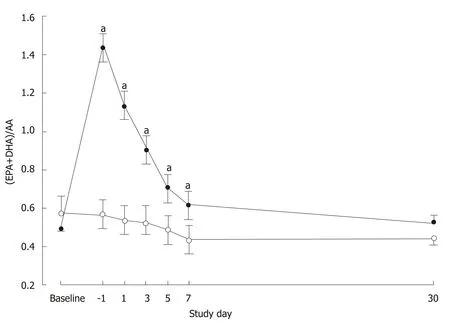
Figure2 Ratio of eicosapentaenoic acid plus docosahexaenoic acid to arachidonic acid (mean ± SE) measured at baseline,day prior to surgery (day-1)and on postoperative days 1,3,5,7 and 30 in patients who received IMPACT preoperatively (solid symbols) compared with patients who received standard care (open symbols).aP < 0.05 vs standard care.
In contrast to the studies of Mikagiet al[8]and Zachariaset al[21],major hepatectomy was performed in 75% of our patients compared to 8% and 21% in the respective earlier studies.This may account,at least in part,for the higher incidence of major complications in our study (25%) compared to the Zacharias study (11%).The markedly higher number of non-infectious complications in the immunonutrition group in the current study may have been a chance effect rather than a result of the treatment.A larger study is required to confirm this.This finding however may have contributed to the greater and more sustained inflammatory response postoperatively in the immunonutrition group,predisposing those patients to infection.One patient in the IMN group contributed 3 of the 15 infectious and 10 of the 40 non-infectious complications observed in that group having suffered aspiration pneumonia and acute respiratory distress syndrome.
The majority of patients in the current study were well-nourished with two patients in each group assessed as malnourished preoperatively (SGA B + C).Malnourished patients experience significantly longer LOS and more major postoperative complications[23],which are attributed to malnutrition associated immune depression[24].Consequently,it has been hypothesized that by providing immunonutrition containing key nutrients with the ability to minimise the early inflammatory response to surgery a more substantial benefit may be seen in malnourished patients[25].If this is the case it might explain,at least in part,the lack of any indication of improved clinical outcomes in the present study.Unoet al[9]did not report nutritional status of their patients and a high prevalence of malnutrition in their cholangiocarcinoma patients may help explain the significant benefits seen with immunonutrition.To date,there are no published meta-analyses evaluating the impact of nutritional status on the treatment effect of immunonutrition.Published meta-analyses have pooled data from randomized trials that include both wellnourished and malnourished patients,with a number of studies not reporting on baseline nutritional status.
Dose and timing of preoperative immunonutrient supplementation are not welldefined.Our protocol conformed to the 500-1000 kcal/d recommended by Waitzberget al[2]and the consensus guidelines from ASPEN[26]and ESPEN[27].Giger-Pabstet al[20]investigated the effect of immunonutrition administered for only 3 days preoperatively based on the findings of a prior study suggesting that the antiinflammatory effect of immunonutrition starts after only two days[28].However,3 days of IMPACT supplementation preoperatively was insufficient to provide any benefit in terms of infectious complications or LOS.The authors concluded based on their own findings and review of the literature that at least five days of preoperative supplementation are required to achieve benefit.
Limitations of the current study include its small size,given it was focused on inflammatory and immune parameters rather than clinical outcome.It was also not placebo-controlled and double-blinded,the latter being less important for endpointsbased on blood assays.However,there was potential for bias in the reporting of complications,most especially for those occurring after hospital discharge.In-hospital complications were assessed by clinicians who were blinded to the group allocation.After discharge,patients were contacted or assessed at clinic visits to monitor complications over the first postoperative month.However,not all complications may have been captured.Up to 25% of postoperative infections,which are largely surgical wound infections,may occur after discharge[17].We did not perform dietary assessments during or at the end of the period of nutritional supplementation so cannot comment on any difference in caloric load between the groups prior to surgery and impact on outcome.
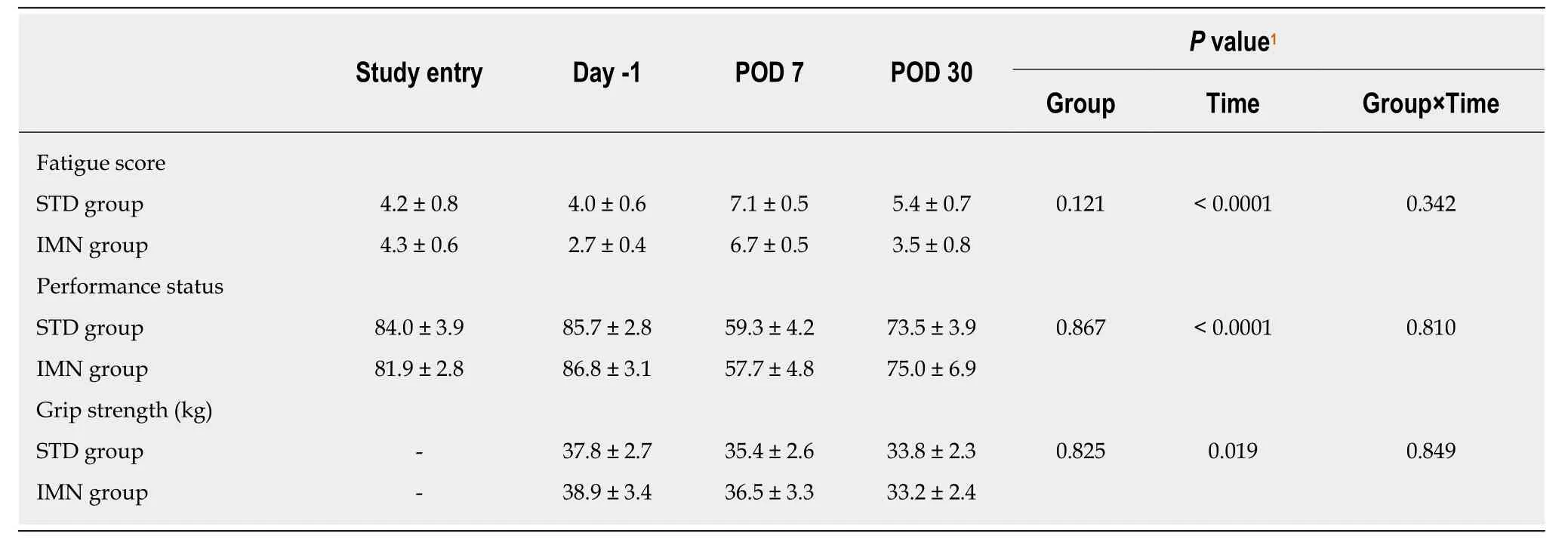
Table2 Fatigue score and performance status measured at study entry,Day-1,POD 7 and POD 30 and grip strength measured at Day-1,POD7 and POD30 in patients who received either immunonutrition or standard care preoperatively
Strengths of the study include:measurement of EPA and DHA plasma concentrations which support likely cell membrane incorporation[29]and resultant biological effects[30];the near-perfect compliance with the immunonutrition product,verified by the EPA+DHA levels in plasma;hospital discharge determination by staff independent of the study;operations performed by the same surgeon using the same surgical technique in all except one patient;and assessment of inflammatory and immune markers in the very early postoperative period (from POD1).
In conclusion,this study failed to show any evidence for suppression of postoperative inflammation or improvement in clinical outcome through providing immunonutrition to well-nourished patients undergoing liver resection.There remains no large scale double-blind trial in liver resection on which to base more definitive conclusions and such a trial,particularly in patients having major resections,is warranted.
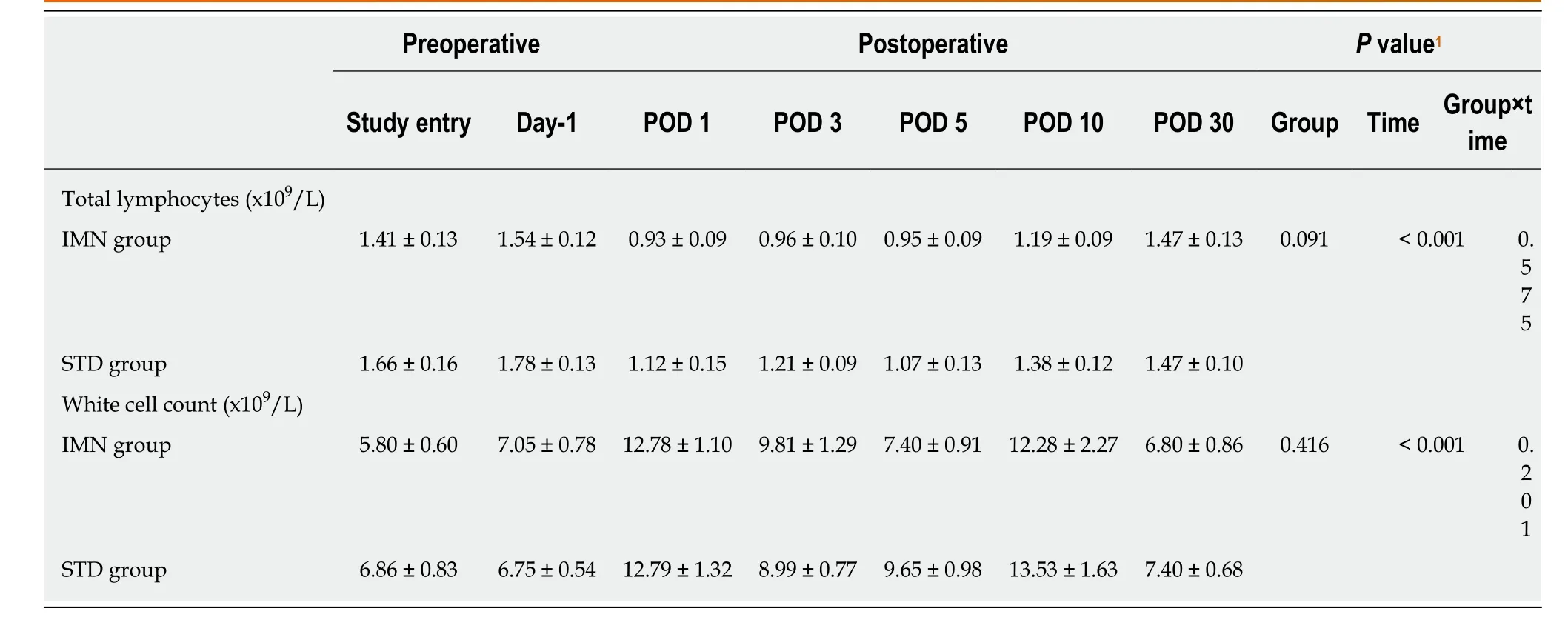
Table3 Total lymphocyte and white cell counts over the pre-and postoperative periods in patients who received either immunonutrition or standard care preoperatively
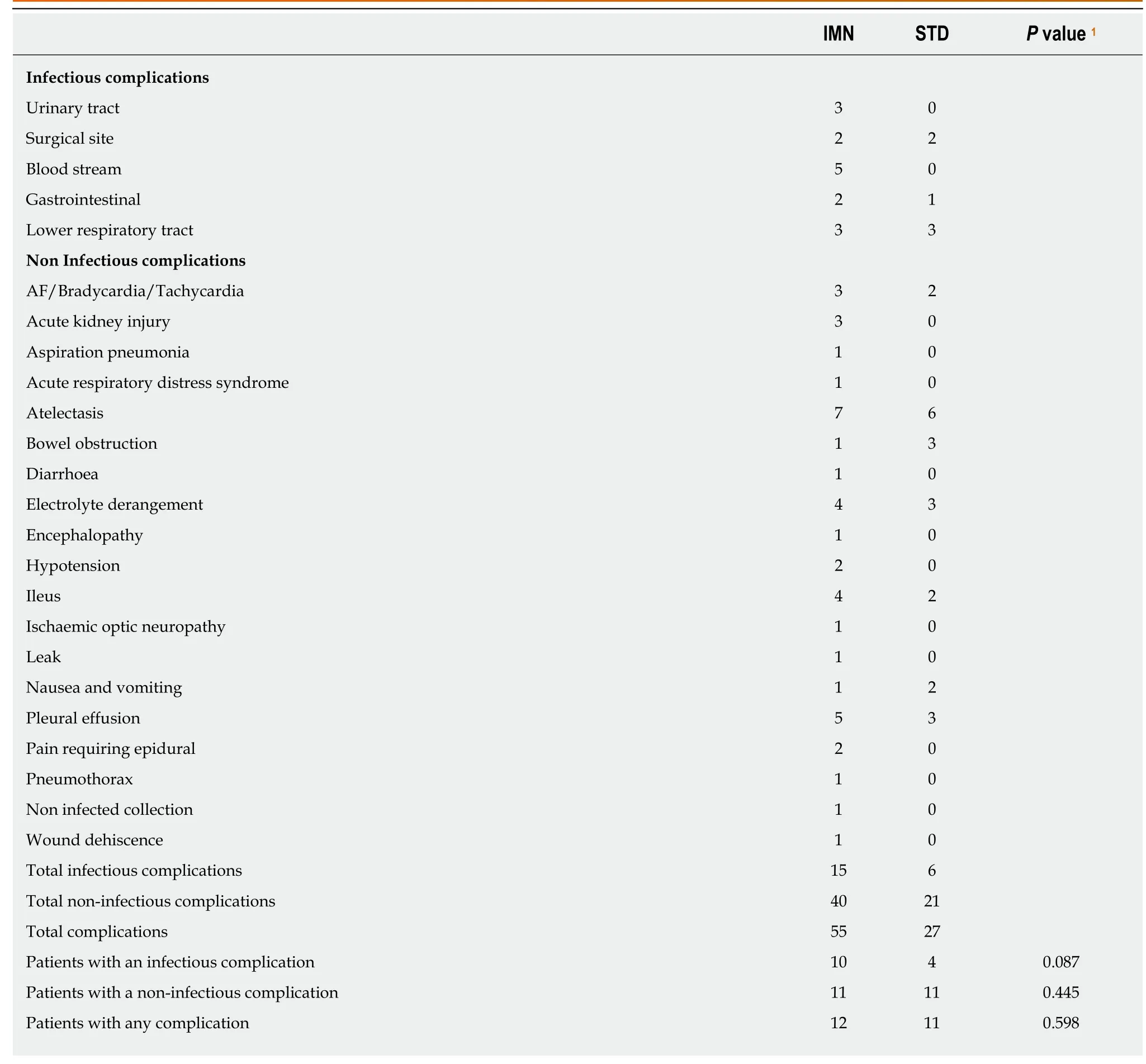
Table4 All complications in patients who received either immunonutrition or standard care preoperatively

1Fisher's exact test.AF:Atrial fibrillation;IMN:Immunonutrition;STD:Standard care.

Table5 Severity of complications with major and minor surgery
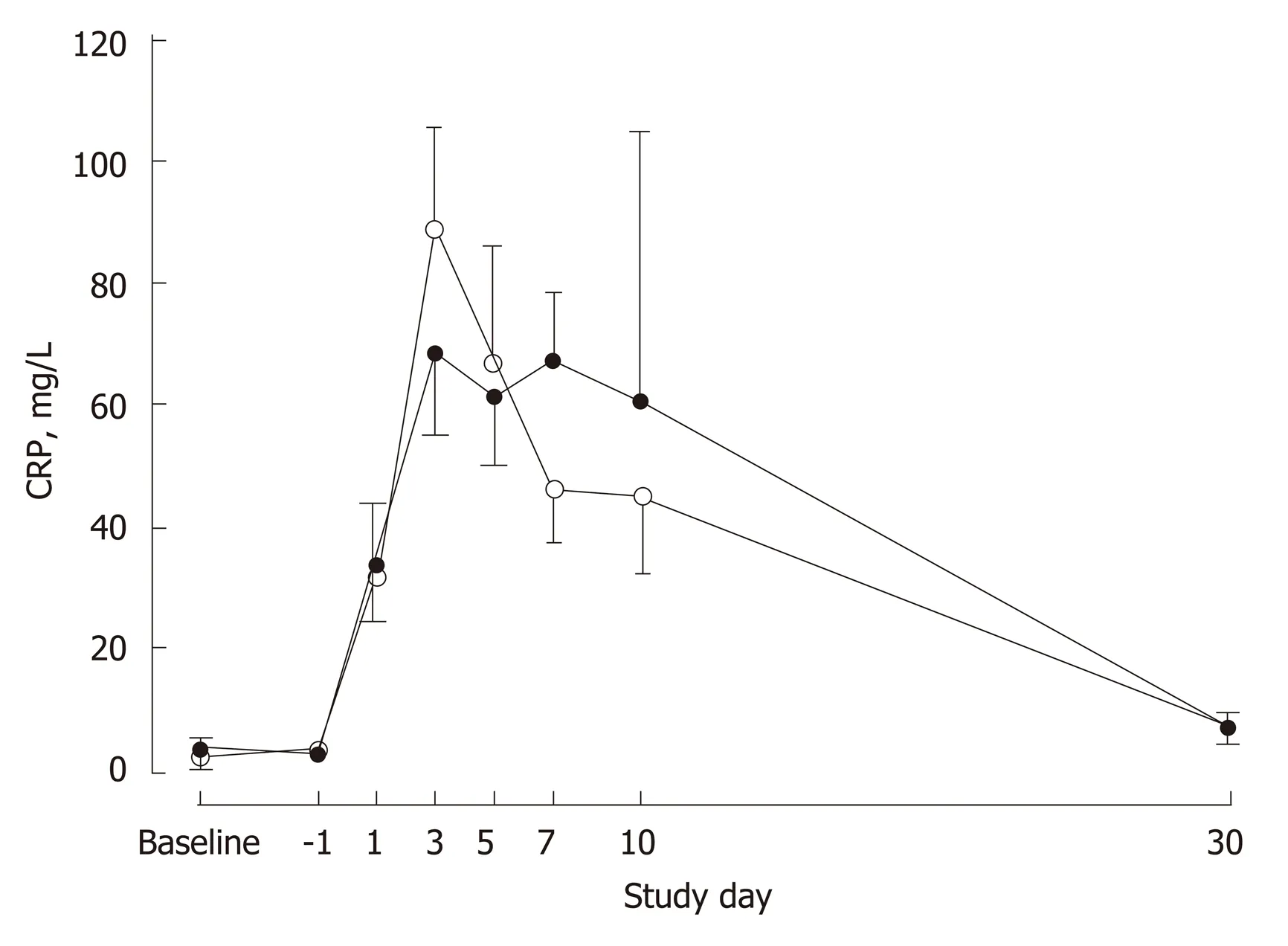
Figure3 Plasma C-reactive protein concentrations (geometric mean ± SE) measured at baseline,day prior to surgery (day-1) and on postoperative days 1,3,5,7 and 30 in patients who received IMPACT preoperatively (solid symbols) compared with patients who received standard care (open symbols).
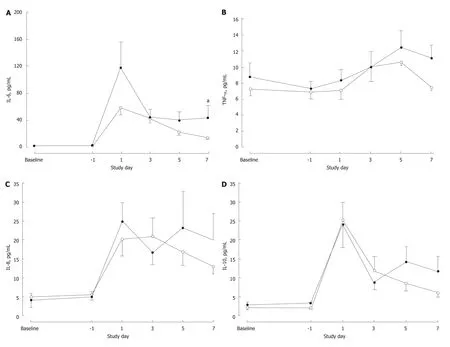
Figure4 Plasma concentrations (geometric mean ± SE) of interleukin-6 (IL-6) (A),TNF-α (B),IL-8 (C) and IL-10 (D) measured at baseline,day prior to surgery (day-1) and on postoperative days 1,3,5,and 7 in patients who received IMPACT preoperatively (solid symbols) compared with patients who received standard care (open symbols).aP < 0.05 vs standard care.
ARTICLE HIGHLIGHTS
Research background
Immunonutrients provided pre- and perioperatively to patients undergoing major gastrointestinal surgery have been shown in a number of studies to reduce postoperative morbidity.Nutritional supplementation enriched in n-3 long-chain fatty acids and arginine has been used in the majority of these studies and these nutrients are thought to modulate the inflammatory and immune responses to surgery leading to improved clinical outcome.
Research motivation
We were motivated to design and implement a randomized trial of immunonutrition in patients undergoing liver resection given that only one such prospective trial had previously been reported.That trial had a high dropout rate and we considered further work was needed.
Research objectives
The main objective of this study was to evaluate the effect of preoperative supplemental immunonutrition,enriched in n-3 fatty acids and arginine,on postoperative inflammatory and immune markers.A secondary objective was to examine effects on clinical outcome.
Research methods
Patients scheduled for non-laparoscopic elective hepatic resection for primary or secondary liver cancer were randomized in an assessor-blinded prospective trial to preoperative immunonutrition (IMPACT Advanced Recovery®,1020 kcal/d) for 5 consecutive days or to standard care.Blood samples were obtained at recruitment,on the day prior to surgery and on postoperative day (POD) 1,3,5 and 7 for measurement of plasma fatty acids and markers of inflammation and immune status.Patients were monitored for 30 POD for infectious and other complications.
Research results
Immune markers did not differ between the groups.Postoperative inflammatory response,as assessed by interleukin-6 concentrations,was more pronounced in the immunonutrition group.Ten patients in the immunonutrition group and 4 in the standard care group developed infectious complications.Major postoperative complications were more common in the immunonutrition group.
Research conclusions
In this study,provision of a preoperative immunonutritional supplement was not associated with post-surgery suppression of inflammation nor with improved clinical outcomes.The higher incidence of major complications in the immunonutrition group may have contributed to these findings.
Research perspectives
Since completion of this study a similar preoperative immunonutrition regime was reported in a randomized trial demonstrating reduced postoperative inflammatory response and improved clinical outcome with immunonutrition.The majority of patients in that study had a relatively rare indication for liver resection.Future efforts should be directed at double-blind trials of immunonutritional formulae,in patients undergoing major liver resections for commonly seen indications,that are adequately powered to assess postoperative infectious complications.
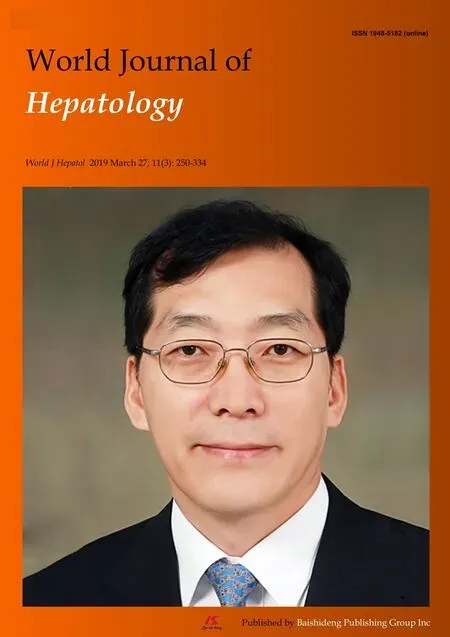 World Journal of Hepatology2019年3期
World Journal of Hepatology2019年3期
- World Journal of Hepatology的其它文章
- Persistent elevation of fibrosis biomarker cartilage oligomeric matrix protein following hepatitis C virus eradication
- Intraperitoneal rupture of the hydatid cyst:Four case reports and literature review
- Angiogenesis of hepatocellular carcinoma: An immunohistochemistry study
- Extreme hyperbilirubinemia:An indicator of morbidity and mortality in sickle cell disease
- Protective action of glutamine in rats with severe acute liver failure
- Hepatocellular carcinoma recurrence after liver transplantation:Risk factors,screening and clinical presentation
